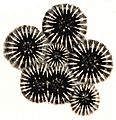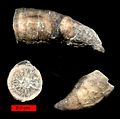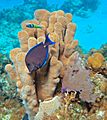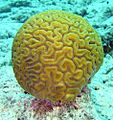Coral facts for kids
Quick facts for kids Coral |
|
|---|---|
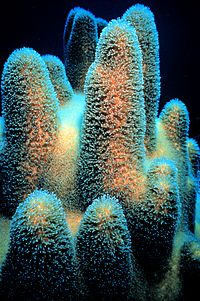 |
|
| Pillar coral, Dendrogyra cylindricus | |
| Scientific classification | |
| Kingdom: | |
| Phylum: | |
| Class: |
Ehrenberg, 1831
|
Corals are amazing sea animals that look a lot like plants or rocks. They are actually tiny creatures called polyps. These polyps live together in huge groups called colonies.
Each coral polyp is a small, soft animal shaped like a bag. It has a mouth at the top, surrounded by tiny arms called tentacles. These tentacles have special stinging cells called nematocysts. Corals use these stingers to catch tiny animals for food.
All the polyps in a coral colony are like identical twins, or clones. They are all exactly alike! Most corals live in warm, tropical oceans. But some types of coral can also be found in cold waters, like near the British Isles and Norway.
Contents
How Corals Get Energy
Most corals get their energy in a very special way. They have tiny, one-celled algae living inside them. These algae are called zooxanthellae (pronounced: zoh-oh-zan-THEL-ee). This is a type of symbiosis, which means two different living things help each other.
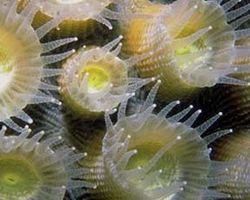
The zooxanthellae are like tiny chefs for the coral. They use sunlight to make food through a process called photosynthesis. This food gives the coral lots of energy. In return, the coral gives the algae a safe place to live. The algae also use the coral's waste products, like carbon dioxide, to grow.
Because these algae need sunlight, most corals live in clear, shallow ocean water. They usually grow at depths less than 60 meters (about 200 feet).
What is Coral Bleaching?
Sometimes, if the ocean water gets too warm or stressed, corals can get sick. When this happens, they push out the helpful algae living inside them. This is called coral bleaching.
The algae give corals their beautiful brown colors. So, when they leave, the coral turns white, looking "bleached." If the stressful conditions don't go away, the coral polyp can eventually die. But if conditions improve, the coral can get new algae and recover.
What Are Coral Reefs?
A coral reef is a huge underwater city built by millions of tiny coral polyps. Each coral polyp creates a hard, stony skeleton around itself. This skeleton is made of a material called calcium carbonate, which is like chalk.
When a coral polyp dies, its hard skeleton stays behind. New polyps then grow on top of the old skeletons. Over many, many years, these layers of skeletons build up. This creates the large, solid structures we call coral reefs.
Different kinds of corals build different shapes of skeletons. Some look like a brain, others like a mushroom, or even a cabbage. All these different shapes together create the amazing and complex structures of a coral reef.
Coral reefs are very important places in the ocean. They provide homes and food for countless other sea animals. Many types of fish, crabs, clams, and sponges live on coral reefs. Coral can also be used to make beautiful jewellery.
Images for kids
-
A coral outcrop on the Great Barrier Reef, Australia
-
A necklace made from coral by the Navajo people
-
Tabulate coral from the Lower Carboniferous period
-
Tabulate coral Aulopora from the Devonian period
-
A fringing coral reef near Eilat, Israel
-
Corals at Tis Beach, Chabahar, Iran
-
Corals at Tis Beach, Chabahar, Iran
See also
 In Spanish: Coral para niños
In Spanish: Coral para niños






